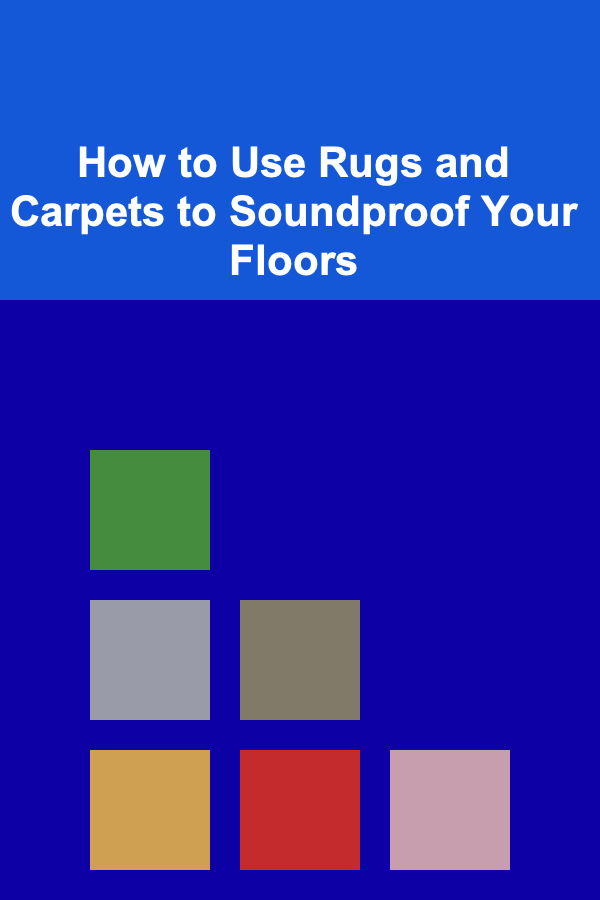
How to Use Rugs and Carpets to Soundproof Your Floors
ebook include PDF & Audio bundle (Micro Guide)
$12.99$5.99
Limited Time Offer! Order within the next:

In modern homes, achieving a quiet and peaceful environment is a priority for many. Noise pollution, whether from external sources or internal disturbances, can significantly reduce the quality of living. One of the most overlooked aspects of soundproofing is the floor. While people often focus on walls and windows, floors play a pivotal role in both transmitting and absorbing sound. Fortunately, rugs and carpets can be highly effective in reducing noise and improving the acoustics of a room.
In this article, we will explore how to use rugs and carpets to soundproof your floors, looking at the science behind sound transmission, the types of noise rugs and carpets can mitigate, and the most effective materials and techniques to use.
Understanding Sound Transmission and the Role of Floors
Before diving into the practicalities of using rugs and carpets for soundproofing, it's essential to understand how sound travels and how floors contribute to the transmission of sound.
Sound Types
Sound can be classified into two primary types:
- Airborne sound: This includes sounds like voices, music, or traffic noise. These sounds travel through the air and can pass through walls, windows, and floors.
- Impact sound: This type of sound results from physical impact or movement, such as footsteps, dropping objects, or furniture being dragged. Impact sound can travel through the structure of the building, causing vibrations in the floors, ceilings, and walls.
Floors are particularly susceptible to impact sound, especially in multi-level buildings, apartments, or homes with hardwood, tile, or concrete flooring. The noise from footsteps, furniture movement, or dropped objects can create vibrations that travel through the structure of the floor, creating an acoustic nuisance for the rooms below.
How Rugs and Carpets Help
Rugs and carpets are effective at reducing both airborne and impact sounds. When placed on a floor, they absorb and dampen sound waves. Carpets, in particular, have a thick and dense texture that helps reduce the amount of sound reflected back into the room, improving overall acoustics. Similarly, rugs can absorb vibrations caused by impact noise, making them highly beneficial for soundproofing.
Why Use Rugs and Carpets for Soundproofing?
There are several reasons why rugs and carpets are a popular choice for soundproofing floors. Here are a few of the primary advantages:
- Absorption of Sound: Both rugs and carpets can absorb sound waves, preventing them from bouncing off hard surfaces and creating echoes within a room. This is particularly important for high-frequency sounds such as speech, music, or television noise.
- Reduction of Impact Noise: Rugs and carpets are highly effective at reducing impact noise like footsteps, dropped objects, or furniture movements. This is crucial for people living in apartments or multi-story homes where noise from above or below can be a significant issue.
- Improved Acoustics: In addition to soundproofing, rugs and carpets improve the overall acoustics of a room. They reduce reverb and echo, making a space feel warmer and more pleasant.
- Aesthetic Appeal: Besides their functional benefits, rugs and carpets also enhance the aesthetic appeal of a room. They can add color, texture, and warmth to any space while serving a practical purpose in soundproofing.
- Ease of Installation: Unlike other forms of soundproofing, such as installing new flooring or adding mass to walls, rugs and carpets are relatively easy to install. They can be placed over existing floors without major construction, making them an ideal solution for renters or those who want a non-permanent option.
Factors to Consider When Using Rugs and Carpets for Soundproofing
While rugs and carpets can be highly effective at soundproofing, the effectiveness depends on several factors. To maximize their soundproofing potential, it is important to consider the following:
1. Material of the Rug or Carpet
The material of the rug or carpet plays a significant role in its ability to absorb sound. Some materials are denser and thicker, providing better soundproofing properties than others.
- Wool: Wool is one of the best materials for soundproofing because it is dense, thick, and natural. It has excellent sound-absorbing qualities and is ideal for reducing both airborne and impact noise.
- Polyester and Nylon: These synthetic materials are also effective at reducing sound, although they may not be as sound-absorbent as wool. However, they are still a good option for soundproofing, and they come in various styles and colors to suit different home décor needs.
- Silk and Cotton: While luxurious, silk and cotton rugs are generally less effective in soundproofing than wool or synthetic options. However, they can still provide some degree of noise reduction if combined with appropriate padding.
- Jute and Hemp: Natural fibers like jute and hemp are often used in rugs, but they tend to be less effective at sound absorption compared to wool or synthetic fibers. However, they can still help dampen sound to some extent and are environmentally friendly.
2. Thickness and Density
The thickness and density of the carpet or rug play a crucial role in its soundproofing capabilities. A thicker and denser material will absorb more sound and reduce noise transmission more effectively.
- Thick Carpets: Thicker carpets generally provide better soundproofing because they have more material to absorb sound waves. They also tend to reduce impact noise more effectively.
- Heavy Rugs: Rugs with a heavy and dense construction, such as those made from high-pile wool or thick synthetic fibers, are better at absorbing sound and minimizing impact noise.
3. Padding and Underlayments
To maximize the soundproofing properties of your rugs and carpets, it's essential to consider the padding or underlayment that goes underneath them. Padding acts as a cushion that helps absorb sound and reduces impact noise.
- Foam Padding: Foam is one of the most common types of carpet padding used to enhance soundproofing. It's relatively inexpensive and provides good sound absorption. Foam padding works particularly well for reducing impact noise from footsteps.
- Rubber Padding: Rubber is another excellent option for soundproofing, particularly for high-traffic areas or spaces with significant noise concerns. It's denser than foam and provides superior sound isolation.
- Felt Padding: Felt is another high-density material that works well for soundproofing. Felt pads are often used under carpets and rugs to absorb sound and reduce vibrations.
4. Size and Coverage
The larger the rug or carpet, the more sound it can absorb. A small rug may not be effective at soundproofing an entire room, especially in spaces with hard floors like hardwood or tile. To achieve optimal soundproofing, you'll need to cover a substantial portion of the floor with thick, dense rugs or carpets.
- Area Rugs: Area rugs can provide good soundproofing for smaller spaces, such as living rooms or bedrooms. However, they are typically not as effective as wall-to-wall carpeting for larger rooms or spaces with heavy foot traffic.
- Wall-to-Wall Carpeting: For the most significant soundproofing effect, wall-to-wall carpeting combined with dense padding is ideal. It covers the entire floor surface and provides maximum noise reduction.
How to Use Rugs and Carpets for Soundproofing
Now that we've covered the key factors to consider when choosing rugs and carpets, let's look at the practical steps for using them effectively to soundproof your floors.
1. Choosing the Right Rug or Carpet
Start by selecting a rug or carpet made from dense, thick material, such as wool or high-pile synthetic fibers. If you're opting for an area rug, choose one large enough to cover a significant portion of the floor. If possible, go for wall-to-wall carpeting for maximum coverage and soundproofing effect.
2. Adding Padding or Underlayment
Once you've chosen your rug or carpet, it's time to add a soundproofing pad or underlayment. For the best results, use thick, dense padding made of foam, rubber, or felt. Ensure the padding is placed directly beneath the rug or carpet to maximize its sound-absorbing properties.
3. Covering High-Traffic Areas
In rooms with high foot traffic, such as living rooms or hallways, place larger rugs or carpets to cover as much floor space as possible. Pay attention to areas where noise transmission is most noticeable, such as near entryways or under furniture.
4. Layering Rugs for Extra Soundproofing
If you have a particularly noisy room, consider layering multiple rugs or carpets on top of each other for enhanced soundproofing. This extra layer of material can further dampen sound and reduce both airborne and impact noise.
5. Maintenance and Cleaning
To ensure your rugs and carpets continue to provide optimal soundproofing, it's important to keep them clean and well-maintained. Regular vacuuming will prevent dirt and debris from building up, which could affect the rug's ability to absorb sound. Additionally, periodic cleaning or professional cleaning may be necessary to maintain the material's density and soundproofing qualities.
Conclusion
Rugs and carpets can be an effective and aesthetically pleasing solution for soundproofing your floors. By selecting the right materials, thickness, and padding, you can significantly reduce both airborne and impact noise in your home. Whether you're looking to create a quieter environment in an apartment, reduce noise in a home theater, or simply enhance the acoustics of a room, rugs and carpets offer a practical and cost-effective way to achieve soundproofing without major construction.
With careful selection and installation, rugs and carpets can transform a noisy space into a peaceful sanctuary, providing not only noise reduction but also added warmth and comfort to your living areas.

How to Create a Stylish Home Office Without Breaking the Bank
Read More
How to Host a Holiday Party and Decorate Your Home for Guests
Read More
How to Manage Pantry Inventory with a Spreadsheet
Read More
How to Plan for Major Life Events (Weddings, Buying a Home, and More)
Read More
What Steps Can You Take to Organize Your Fitness Equipment?
Read More
How to Practice Detachment from Outcomes
Read MoreOther Products

How to Create a Stylish Home Office Without Breaking the Bank
Read More
How to Host a Holiday Party and Decorate Your Home for Guests
Read More
How to Manage Pantry Inventory with a Spreadsheet
Read More
How to Plan for Major Life Events (Weddings, Buying a Home, and More)
Read More
What Steps Can You Take to Organize Your Fitness Equipment?
Read More